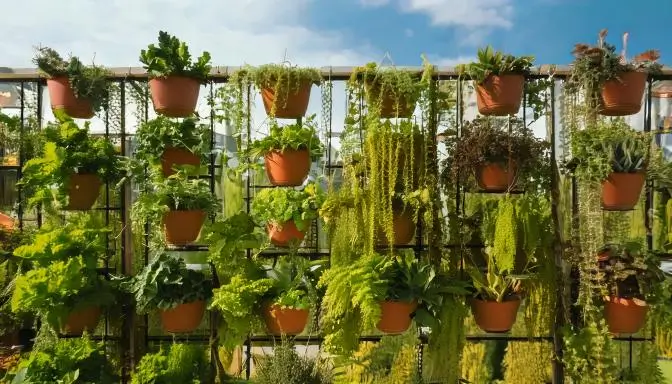
Vertical gardening is an innovative way to make the most of limited space while adding greenery to your home or garden. Whether you’re dealing with a small backyard, an apartment balcony, or even an indoor wall, vertical gardens allow you to grow a wide range of plants. However, not all plants are suited for vertical gardening, so choosing the right ones for your setup is important. In this guide, we’ll explore the best plants for vertical gardens, helping you create a thriving and beautiful green space.
Why Choose Vertical Gardening?
Vertical gardening is an excellent solution for those with limited horizontal space. By growing plants upward, you can transform unused walls or structures into lush, green areas. Vertical gardens are not only space-saving but also add aesthetic appeal, improve air quality, and create a relaxing environment.
Vertical gardens can be installed indoors or outdoors and are suitable for various types of plants, including herbs, vegetables, flowers, and even small fruits. The key to success is selecting the right plants that will thrive in a vertical setting.
Best Plants for Vertical Gardening
1. Herbs
Herbs are among the most popular choices for vertical gardening due to their compact size and ease of growth. They are perfect for both indoor and outdoor vertical gardens and require minimal maintenance. Some of the best herbs for vertical gardening include:
- Basil: This fragrant herb is easy to grow and thrives in well-drained soil. It needs plenty of sunlight, making it a great choice for outdoor vertical gardens.
- Thyme: A hardy herb that requires little water, thyme is perfect for vertical gardens. Its trailing nature makes it a visually appealing addition.
- Mint: Known for its refreshing aroma, mint is a fast-growing herb that does well in containers. It can spread quickly, so it’s best grown in a confined space.
- Parsley: Parsley is a versatile herb that grows well in vertical gardens. It prefers partial shade and regular watering.
2. Succulents
Succulents are ideal for vertical gardens because they require minimal care and can thrive in various conditions. They are also visually stunning, with their unique shapes and colors adding a decorative touch to your vertical garden. Some popular succulents for vertical gardens include:
- Sedum: This hardy succulent is perfect for vertical gardens, as it can tolerate drought and poor soil conditions. Its trailing varieties create a cascading effect.
- Echeveria: Known for its rosette shape, Echeveria adds a striking look to any vertical garden. It requires minimal water and plenty of sunlight.
- String of Pearls: This unique succulent features small, bead-like leaves that trail down, making it a perfect choice for vertical gardening.
- Aloe Vera: Aloe vera is a striking succulent plant known for its medicinal properties.
3. Ferns
Ferns are an excellent choice for shaded vertical gardens, as they prefer low light and high humidity. They add a lush, green look to your vertical garden and are relatively easy to care for. Some of the best ferns for vertical gardening include:
- Boston Fern is a classic indoor plant known for its feathery fronds and ability to purify the air. It thrives in indirect light and requires regular misting.
- Maidenhair Fern: This delicate fern has soft, lace-like leaves that add an elegant touch to any vertical garden. It prefers a moist environment and indirect light.
- Staghorn Fern: Staghorn Ferns have unique, antler-shaped fronds that stand out in vertical gardens. They grow well mounted on boards or in hanging baskets.
4. Climbing Plants
Climbing plants are a natural fit for vertical gardens, as they are designed to grow upward. These plants can quickly cover a wall or trellis, creating a lush green backdrop. Some of the top climbing plants for vertical gardens are:
- English Ivy: A classic climber, English Ivy is perfect for covering walls and trellises. It’s easy to grow and can thrive in both sun and shade.
- Clematis: Known for its stunning flowers, Clematis is a popular choice for vertical gardens. It prefers well-drained soil and plenty of sunlight.
- Sweet Pea: Sweet Pea is a fragrant climber that produces beautiful, colorful flowers. It thrives in cool weather and requires support to climb.
- Morning Glory: This fast-growing vine is perfect for adding height to your vertical garden. It produces vibrant, trumpet-shaped flowers and loves full sun.
5. Vegetables
Growing vegetables in a vertical garden is a great way to maximize space while enjoying fresh produce. Many vegetables are well-suited for vertical gardening, especially those that can be trained to grow upward. Some of the best vegetables for vertical gardens include:
- Tomatoes: Cherry tomatoes, in particular, are ideal for vertical gardening. They can be trained to climb a trellis or grown in hanging baskets.
- Cucumbers: As natural climbers, cucumbers thrive in vertical gardens.
- Peas: Peas are perfect for vertical gardening, as they can easily be trained to grow up a trellis. They prefer cooler weather and need well-drained soil.
- Zucchini: Zucchini plants can be trained to grow vertically, saving space and making harvesting easier. They need full sun and regular watering.
6. Ornamental Flowers
Adding ornamental flowers to your vertical garden can create a vibrant and colorful display. Many flowering plants are well-suited for vertical gardens, adding beauty and fragrance to your space. Some of the best ornamental flowers for vertical gardens include:
- Petunias: Petunias are a popular choice for vertical gardens due to their cascading growth habit and bright, colorful flowers. They thrive in full sun and well-drained soil.
- Begonias: Begonias are shade-loving plants that produce beautiful, vibrant flowers. They are perfect for adding color to shaded vertical gardens.
- Geraniums: Geraniums are hardy plants that produce abundant blooms. They do well in containers and prefer full sun.
- Fuchsias: Fuchsias are known for their pendulous flowers and are perfect for hanging baskets or wall-mounted vertical gardens. They prefer partial shade and regular watering.
Tips for Successful Vertical Gardening
To ensure your vertical garden thrives, consider the following tips:
- Choose the Right Plants: Select plants that are well-suited for vertical gardening and can thrive in your conditions (e.g., light, humidity).
- Use Quality Soil: Use a high-quality potting mix that provides good plant drainage and nutrients.
- Watering: Vertical gardens may require more frequent watering, as they can dry out quickly. Consider using a drip irrigation system to ensure consistent moisture.
- Fertilize Regularly: Feed your plants with a balanced fertilizer to promote healthy growth. Follow the instructions on the packaging to avoid over-fertilizing.
- Provide Support: Ensure climbing plants have adequate support to grow upward, such as trellises or stakes.
Conclusion
Vertical gardening is a versatile and space-saving way to bring greenery into your home or garden. By selecting the right plants for vertical gardening—herbs, succulents, ferns, climbing plants, vegetables, or ornamental flowers—you can create a thriving vertical garden that enhances your space and brings joy throughout the year. With careful planning and maintenance, your vertical garden will flourish, providing beauty, fresh produce, and a touch of nature to even the smallest spaces.

